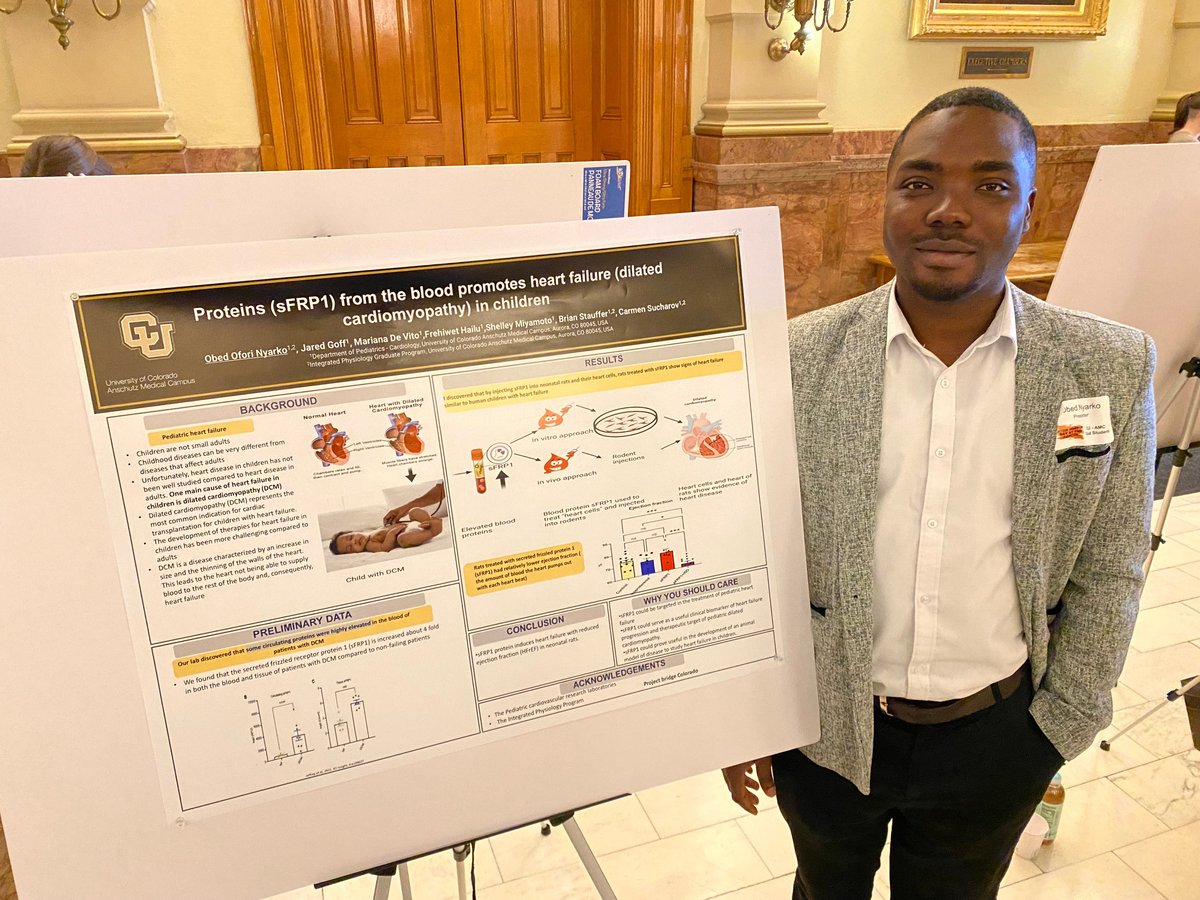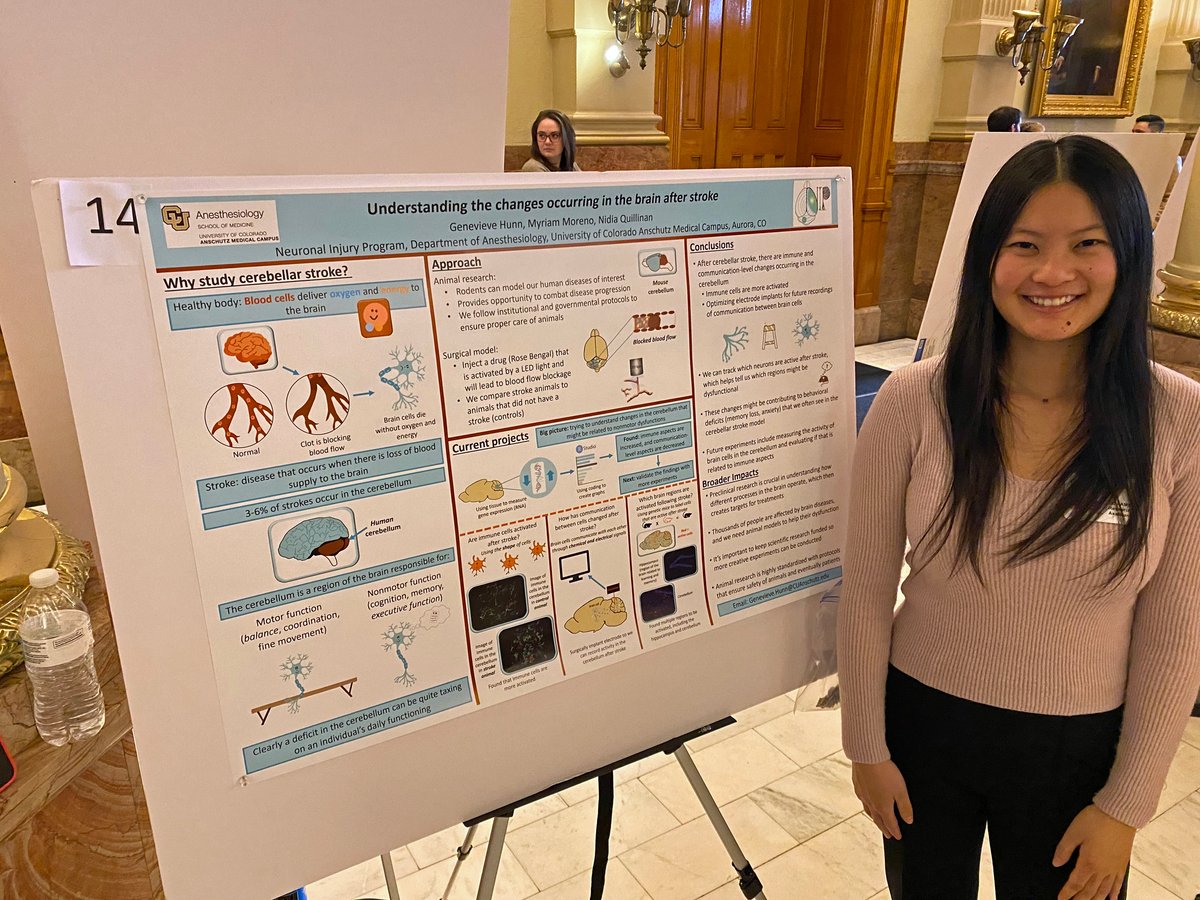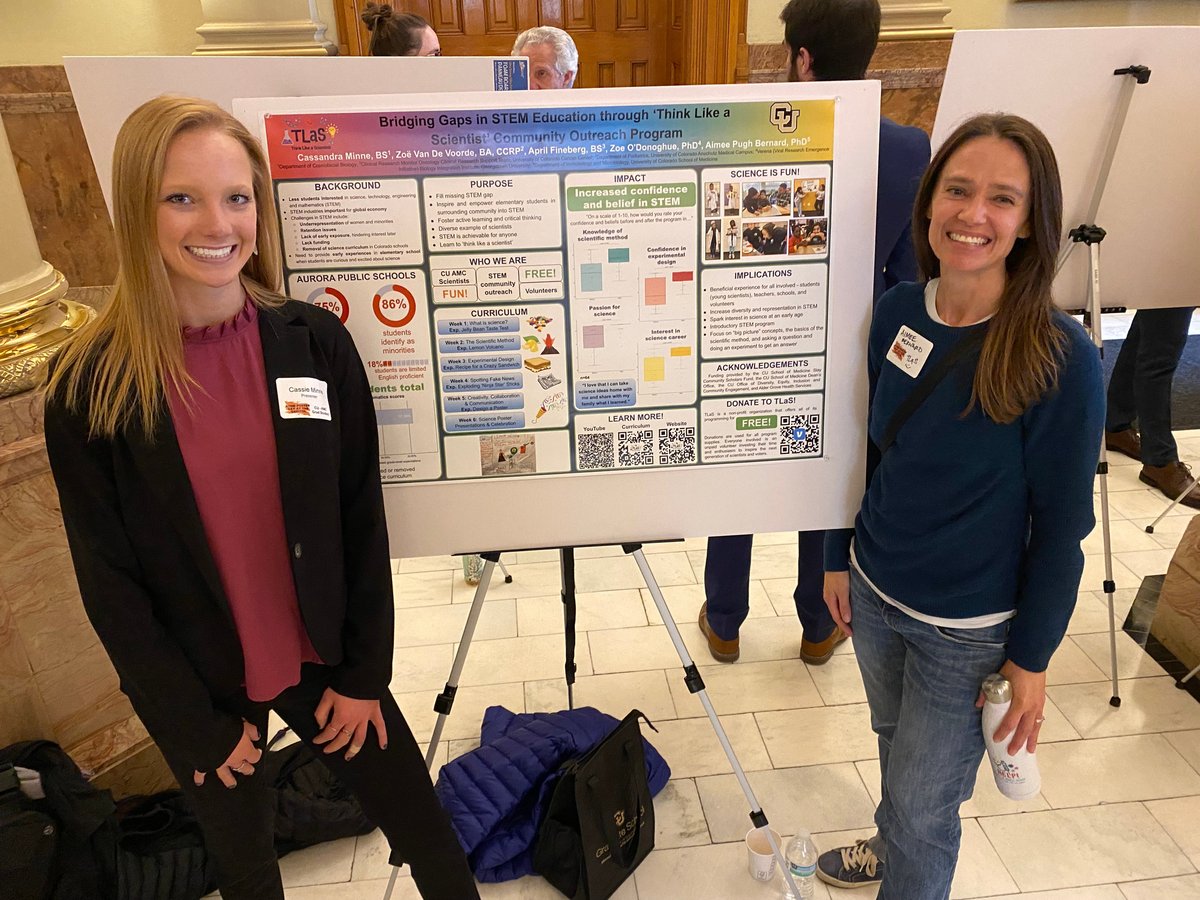Nearly 50 young scientists gathered in the resplendent halls of the Colorado State Capitol in Denver on March 13, standing next to colorful posters illustrating their research work, chatting with curious passersby.
It was the annual STEM Poster Day at the Capitol, organized by Project Bridge Colorado, a campus group at the University of Colorado Anschutz Medical Campus. Project Bridge invited undergraduates, graduate students, and postdocs from across the state to present their research work to lawmakers and the public with as little jargon as possible.
The CU School of Medicine was well represented at the event in the Capitol’s ornate West Foyer and Rotunda, along with early-career scientists from other CU campuses and Colorado universities as well as the National Renewable Energy Laboratory in Golden.
Laura Leaton, a graduate student in immunology, spoke to a passerby of finding “what might be a previously unknown mechanism of keeping inflammation low in the gut.” Obed Nyarko, a graduate student in integrated physiology and an MD from Ghana, talked about studying proteins in the blood that promote heart failure in children. And Bridget Alexander, also an immunology grad student, explained how understanding the role of a gene in Type-1 diabetes could be a step on the path to future treatments.
Fostering public interest
Laurie Lyon and Madeline Akbari, both microbiology doctoral candidates at CU Anschutz, are Project Bridge Colorado members who helped organize the Capitol event. They say their group’s mission is to foster public interest in primary science research – and to help young scientists learn to communicate their work more effectively to a general audience.
“It’s an event to show legislators and the public how important research is to Coloradans,” Lyon says. “Anyone should be able to come here, chat with a scientist and understand what they’re doing. We train these scientists on how to make posters that can be understood by a general audience. They go through a workshop that we put on a few weeks before the event, and they get feedback on drafts of their poster.”
Akbari says presenters are encouraged to emphasize a connection to Colorado in their posters. “If it’s about a disease, for example, what percentage of Coloradans are impacted? Having community connections makes their work more personal.”
The mandate to keep things simple and relatable meant that some of the Capitol presentations contained elements that might not make their way into a professional journal.
In their poster about using an artificial-intelligence tool to create 3D models of organs more quickly before anatomy classes, anatomy grad students Abigail Wohlfert and Brendan Hinckley wrote that their findings were “totally awesome.” And anesthesiology research assistant Genenieve Hunn’s poster featured cartoon figures of smiling immune cells.

Obed Nyarko, a graduate student in integrated physiology, with Nyarko’s poster, “Proteins (sFRP1) from the blood promotes heart failure (dilated cardiomyopathy) in children,” at STEM Poster Day at the Capitol, March 13, 2024. Photo: Mark Harden | CU School of Medicine. Click arrow on right side to advance to next image.

Genevieve Hunn, a research assistant in anesthesiology and president of Women in STEM, a campus group, with Hunn’s poster, “Understanding the changes occurring in the brain after stroke,” at STEM Poster Day at the Capitol, March 13, 2024. Photo: Mark Harden | CU School of Medicine

Abigail Wohlfert and Brendan Hinckley, graduate students in the Modern Human Anatomy Program, with their poster, “The Total Segmentator tool is totally awesome at automatic organ remodeling for education,” at STEM Poster Day at the Capitol, March 13, 2024. Photo: Mark Harden | CU School of Medicine

Eric Stokes, a graduate student in pharmacology, with Stokes’ poster, “Utilizing a disease-associated mutation to investigate the biology underlying animal behaviors,” at STEM Poster Day at the Capitol, March 13, 2024. Photo: Mark Harden | CU School of Medicine

Bridget Alexander, a graduate student in immunology, with Alexander’s poster, “Deciphering genetic predisposition in the development of Type-1 diabetes (T1D),” at STEM Poster Day at the Capitol, March 13, 2024. Photo: Mark Harden | CU School of Medicine

Laura Leaton, a graduate student in immunology, with Leaton’s poster, “Finding new immunoregulatory mechanisms in the gut,” at STEM Poster Day at the Capitol, March 13, 2024. Photo: Mark Harden | CU School of Medicine

Cassandra Minne, a graduate student in molecular biology, and Aimee Bernard, PhD, an assistant professor of immunology and microbiology, with their poster on TLaS (Think Like a Scientist), a CU Anschutz-based community-outreach initiative that organizes education programs in Aurora school grades lacking STEM curriculum, at STEM Poster Day at the Capitol, March 13, 2024. Photo: Mark Harden | CU School of Medicine
‘High-powered stuff’
Those who stopped by to gaze at the posters and chat with presenters said they were impressed.
“This is high-powered stuff,” says Bob McQuaid, an optometrist who doubles as a Capitol tour guide. He methodically made his way from one poster to the next. “It’s all very interesting. I can almost grasp it all, the concept behind much of this. This is real science, as opposed to magazine articles.”
Another visitor was Jack Desloge, who lives down the street and is friends with some of the CU Anschutz students who were presenting. “They did a good job dialing it down into practical terms. That’s the most important thing to me, to bring it down to a consumable level. The people I’ve talked to, they’ve done a really good job of that.”
Tucked among the research posters was a presentation by members of TLaS (Think Like a Scientist), a CU Anschutz-based community-outreach volunteer group that organizes science-education programs in Aurora schools that offer little or no STEM curriculum in the fourth and fifth grades. The program is funded in part by the CU School of Medicine and its Slay Community Scholars fund.
“This is a big problem,” says Cassandra Minne, a graduate student in molecular biology and a TLaS volunteer. “So we go in and offer a six-week curriculum. We teach basic science concepts like the scientific method, how to collaborate and write up a poster, and we do fun experiments with them.”
Another Project Bridge Colorado event aimed at fostering young researchers’ communications skills is called the Science Gong Show, patterned after a former TV amateur-talent show in which panelists rejected contestant performers by ringing a big gong. In Project Bridge’s version, usually held at local breweries, cowbells are handed out to attendees, and eight to 10 scientists present their work in three minutes or less. “If they say any words that you don’t understand, you ring your bell,” Lyon says.
Akbari says she got involved in Project Bridge “because I wanted to understand science communication and how to do that better. Since COVID, there’s been a lot of science miscommunication and misunderstandings. So I wondered, how can I make this better? Because communicating science to the public is really important.”
Posters from the 2024 STEM Poster Day at the Capitol will be available soon at the Project Bridge Colorado website.



